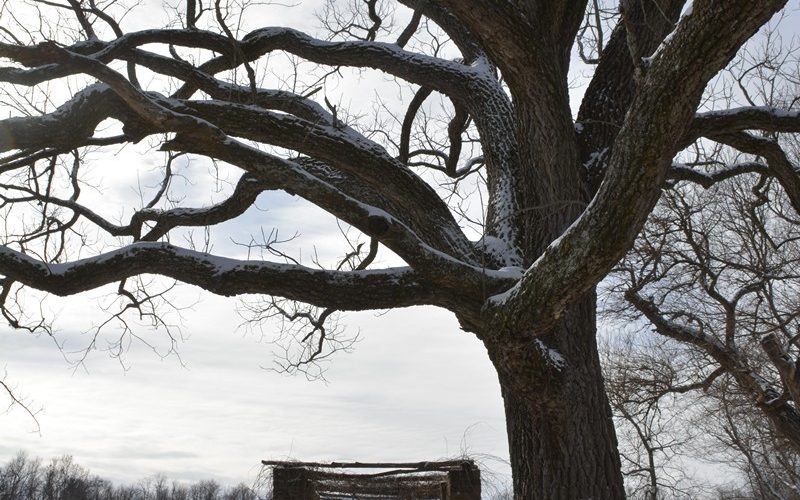
Staff Photo Amanda Bancroft
Black walnut trees are among the first to lose their leaves in fall and the last to grow them in the spring. This tree just outside Fayetteville is around one hundred years old and thriving.
They may look dead, but most wintertime trees are playing ‘possum. Their snowy wonderland branches along a skyline resemble black veins feeding the air, stretching out in a thin tangle of spaghetti strands or in full kinky-hair beauty. Trees in their winter garb look nothing like the princess blossoms of spring, the broccoli they bush into during summer, or the fiery rainbow of fall. Although they seem inert, winter is an important time for trees that are adapted to the season.
The first trees on our planet were only found in the tropics because trees hadn’t yet evolved winter adaptations. Drought-adapted trees were already partly adapted to cold climates because of their ability to avoid getting gas bubbles in their plumbing during drought stress. Gas bubbles could also form when the water inside trees freezes, and once the water becomes liquid again, those air bubbles prevent the flow of molecules upwards inside the trees.
A second adaptation is sugary sap, which is like a natural antifreeze to prevent ice from forming and breaking the cell walls inside trees. Maple syrup is thus a kind of harvest of tree antifreeze from the sugar maple! However, a cold enough freeze can cause damage in even cold-hardy trees, which is why ice storms can kill branches and even entire trees. Trees have many more adaptations not described here, and some of their season-enduring wonders are still mysteries to science.
Most but not all trees focus on growing leaves in the spring, expanding their trunks in summer, and root growth in fall and winter. Trees are dormant in winter, so their growth, metabolism and energy consumption slow down to a crawl. Deciduous trees drop their leaves to prepare for the cold weather. But not the evergreens. Like Madeline to the tiger at the zoo, evergreens say “Pooh-pooh!” to the threat of winter. While they do lose their needles, they don’t drop them all at once, allowing the tree to continue photosynthesizing year-round. But water is necessary for photosynthesis, and it’s limited in winter, so evergreen leaves are tightly wrapped into needles coated in a waxy substance that limits water loss.
Many people find it easier to identify trees by their summer leaves or autumn color, but it’s also possible to ID trees in winter. No other tree in North America has such large thorns as the honey locust. Even their thorns have thorns! Bark is often another clue. Sycamores have characteristic white bark at the tops of branches and often retain their seed balls. Oak trees are famous for hanging onto their leaves until spring. Evergreen conifers can also stand out in winter, but there are many kinds native to Northwest Arkansas. Next time you’re out walking, admire the bare deciduous or bushy evergreen trees battling the winter days.
Amanda Bancroft is a writer, artist, and naturalist building an off-grid cottage for land conservation on Mt. Kessler. She and her husband Ryan blog about their adventures and offer a solar-hosted online educational center on how to make a difference with everyday choices at: www.RipplesBlog.org.










